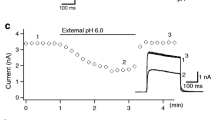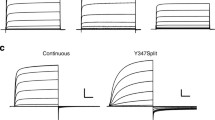Abstract
The Kv1.3 channel inactivates via the P/C-type mechanism, which is influenced by a histidine residue in the pore region (H399, equivalent of Shaker 449). Previously we showed that the electric field of the protonated histidines at low extracellular pH (pHe) creates a potential barrier for K+ ions just outside the pore that hinders their exit from the binding site controlling inactivation (control site) thereby slowing inactivation kinetics. Here we examined the effects of extracellular potassium [K+]e and pHe on the rate of inactivation of Kv1.3 using whole-cell patch-clamp. We found that in 150 mM [K+]e inactivation was accelerated upon switching to pHe 5.5 as opposed to the slowing at 5 mM [K+]e. The transition from slowing to acceleration occurred at 40 mM [K+]e, whereas this “turning point” was at 20 mM [K+]e for inward currents. The rate of entry of Ba2+ ions from the extracellular space to the control site was significantly slowed by low pHe in wild-type hKv1.3, but it was insensitive to pHe in H399K and H399L mutants. Based on these observations we expanded our model and propose that the potential barrier created by the protonated histidines impedes the passage of K+ ions between the extracellular medium and the control site in both directions and the effect on inactivation rate (acceleration or slowing) depends on the relative contribution of filling from the extracellular and intracellular sides.




Similar content being viewed by others
References
Andalib P, Consiglio JF, Trapani JG, Korn SJ (2004) The external TEA binding site and C-type inactivation in voltage-gated potassium channels. Biophys J 87:3148–3161
Baukrowitz T,Yellen G (1995) Modulation of K+ current by frequency and external [K+]: a tale of two inactivation mechanisms. Neuron 15:951–960
Baukrowitz T,Yellen G (1996) Use-dependent blockers and exit rate of the last ion from the multi-ion pore of a K+ Channel. Science 271:653–656
Busch AE, Hurst RS, North RA, Adelman JP, Kavanaugh MP (1991) Current inactivation involves a histidine residue in the pore of the rat lymphocyte potassium channel RGK5. Biochem Biophys Res Commun 179:1384–1390
Choi KL, Aldrich RW, Yellen G (1991) Tetraethylammonium blockade distinguishes two inactivation mechanisms in voltage-activated K+ channels. Proc Natl Acad Sci USA 88:5092–5095
Claydon TW, Boyett MR, Sivaprasadarao A, Ishii K, Owen JM, O’Beirne HA, Leach R, Komukai K, Orchard CH (2000) Inhibition of the K+ channel kv1.4 by acidosis:protonation of an extracellular histidine slows the recovery from N-type inactivation. J Physiol 526(Pt 2):253–264
Claydon TW, Boyett MR, Sivaprasadarao A, Orchard CH (2002) Two pore residues mediate acidosis-induced enhancement of C-type inactivation of the Kv1.4 K(+) channel. Am J Physiol Cell Physiol 283:C1114–C1121
Claydon TW, Makary SY, Dibb KM, Boyett MR (2004) K+ activation of kir3.1/kir3.4 and kv1.4 K+ channels is regulated by extracellular charges. Biophys J 87:2407–2418
Claydon TW, Vaid M, Rezazadeh S, Kwan DC, Kehl SJ, Fedida D (2007) A direct demonstration of closed-state inactivation of K+ channels at low pH. J Gen Physiol 129:437–455
Consiglio JF, Andalib P, Korn SJ (2003) Influence of pore residues on permeation properties in the Kv2.1 potassium channel. Evidence for a selective functional interaction of K+ with the outer vestibule. J Gen Physiol 121:111–124
Deutsch C, Chen L-Q (1993) Heterologous expression of specific K+ channels in T lymphocytes: functional consequences for volume regulation. Proc Natl Acad Sci USA 90:10036–10040
Deutsch C, Lee SC (1989) Modulation of K+ currents in human lymphocytes by pH. J Physiol (Lond) 413:399–413
Eduljee C, Claydon TW, Viswanathan V, Fedida D, Kehl SJ (2007) SCAM analysis reveals a discrete region of the pore turret that modulates slow inactivation in Kv1.5. Am J Physiol Cell Physiol 292:C1041–C1052
Fedida D, Maruoka ND, Lin S (1999) Modulation of slow inactivation in human cardiac Kv1.5 channels by extra- and intracellular permeant cations. J Physiol 515(Pt 2):315–329
Gomez-Lagunas F (1997) Shaker B K+ conductance in Na+ solutions lacking K+ ions: a remarkably stable non-conducting state produced by membrane depolarizations. J Physiol 499(Pt 1):3–15
Grissmer S,Cahalan MD (1989) Divalent ion trapping inside potassium channels of human T lymphocytes. J Gen Physiol 93:609–630
Hamill OP, Marty A, Neher E, Sakmann B, Sigworth FJ (1981) Improved patch-clamp techniques for high-resolution current recording from cells and cell-free membrane patches. Pflugers Arch 391:85–100
Harris RE, Larsson HP, Isacoff EY (1998) A permanent ion binding site located between two gates of the Shaker K+ channel. Biophys J 74:1808–1820
Heginbotham L,MacKinnon R (1992) The aromatic binding site for tetraethylammonium ion on potassium channels. Neuron 8:483–491
Hoshi T, Zagotta WN, Aldrich RW (1990) Biophysical and molecular mechanisms of Shaker potassium channel inactivation [see comments]. Science 250:533–538
Hoshi T, Zagotta WN, Aldrich RW (1991) Two types of inactivation in Shaker K+ channels:effects of alterations in the carboxy-terminal region. Neuron 7:547–556
Jager H, Grissmer S (2001) Regulation of a mammalian Shaker-related potassium channel, hKv1.5, by extracellular potassium and pH. FEBS Lett 488:45–50
Kehl SJ, Eduljee C, Kwan DC, Zhang S, Fedida D (2002) Molecular determinants of the inhibition of human Kv1.5 potassium currents by external protons and Zn(2+). J Physiol 541:9–24
Kiss L,Korn SJ (1998) Modulation of C-type inactivation by K+ at the potassium channel selectivity filter. Biophys J 74:1840–1849
Kiss L, LoTurco J, Korn SJ (1999) Contribution of the selectivity filter to inactivation in potassium channels. Biophys J 76:253–263
Li X, Bett GC, Jiang X, Bondarenko VE, Morales MJ, Rasmusson RL (2003) Regulation of N- and C-type inactivation of Kv1.4 by pHo and K+: evidence for transmembrane communication. Am J Physiol Heart Circ Physiol 284:H71–H80
Liu Y, Jurman ME, Yellen G (1996) Dynamic rearrangement of the outer mouth of a K+ channel during gating. Neuron 16:859–867
Loots E, Isacoff EY (1998) Protein rearrangements underlying slow inactivation of the Shaker K+ channel. J Gen Physiol 112:377–389
Loots E, Isacoff EY (2000) Molecular coupling of S4 to a K+ channel’s slow inactivation gate. J Gen Physiol 116:623–635
López-Barneo J, Hoshi T, Heinemann SH, Aldrich RW (1993) Effects of external cations and mutations in the pore region on C-type inactivation of Shaker potassium channels. Recept Channels 1:61–71
Matteson DR, Deutsch C (1984) K channels in T lymphocytes: a patch clamp study using monoclonal antibody adhesion. Nature 307:468–471
Neyton J, Miller C (1988) Discrete Ba2+ block as a probe of ion occupancy and pore structure in the high-conductance Ca2+ -activated K+ channel. J Gen Physiol 92:569–586
Nguyen AN, Kath JC, Hanson DC, Biggers MS, Cannif PC, Donovan CB, Mather RJ, Bruns MJ, Rauer H, Aiyar J, Lepple-Wienhues A, Gutman GA, Grissmer S, Cahalan MD, Chandy KG (1996) Novel nonpeptide agents potently block the C-type inactivated conformation of Kv1.3 and suppress T cell activation. Mol Pharmacol 50:1672–1679
Ogielska EM, Aldrich RW (1999) Functional consequences of a decreased potassium affinity in a potassium channel pore. Ion interactions and C-type inactivation. J Gen Physiol 113:347–358
Olcese R, Latorre R, Toro L, Bezanilla F, Stefani E (1997) Correlation between charge movement and ionic current during slow inactivation in Shaker K+ channels. J Gen Physiol 110:579–589
Perez-Cornejo P (1999) H+ ion modulation of C-type inactivation of Shaker K+ channels. Pflugers Arch 437:865–870
Rasmusson RL, Morales MJ, Castellino RC, Zhang Y, Campbell DL, Strauss HC (1995) C-type inactivation controls recovery in a fast inactivating cardiac K+ channel (Kv1.4) expressed in Xenopus oocytes. J Physiol 489(Pt 3):709–721
Somodi S, Varga Z, Hajdu P, Starkus JG, Levy DI, Gaspar R, Panyi G (2004) pH dependent modulation of Kv1.3 inactivation: the role of His399. Am J Physiol Cell Physiol 287:C1067–C1076
Starkus JG, Varga Z, Schonherr R, Heinemann SH (2003) Mechanisms of the inhibition of Shaker potassium channels by protons. Pflugers Arch 447:44–54
Steidl JV, Yool AJ (1999) Differential sensitivity of voltage-gated potassium channels Kv1.5 and Kv1.2 to acidic pH and molecular identification of pH sensor. Mol Pharmacol 55:812–820
Yellen G (1998) The moving parts of voltage-gated ion channels. Q Rev Biophys 31:239–295
Zagotta WN, Hoshi T, Aldrich RW (1990) Restoration of inactivation in mutants of Shaker potassium channels by a peptide derived from ShB [see comments]. Science 250:568–571
Zhang S, Eduljee C, Kwan DC, Kehl SJ, Fedida D (2005) Constitutive inactivation of the hKv1.5 mutant channel, H463G, in K+-free solutions at physiological pH. Cell Biochem Biophys 43:221–230
Zhou Y, Morais-Cabral JH, Kaufman A, MacKinnon R (2001) Chemistry of ion coordination and hydration revealed by a K+ channel-Fab complex at 2.0 A resolution. Nature 414:43–48
Acknowledgments
We thank the careful technical assistance of Cecila Nagy. This study was supported by Hungarian grants OTKA K60740, K73080, NK61412 and ETT 068/2006.
Author information
Authors and Affiliations
Corresponding author
Additional information
Regional Biophysics Conference of the National Biophysical Societies of Austria, Croatia, Hungary, Italy, Serbia, and Slovenia.
Rights and permissions
About this article
Cite this article
Somodi, S., Hajdu, P., Gáspár, R. et al. Effects of changes in extracellular pH and potassium concentration on Kv1.3 inactivation. Eur Biophys J 37, 1145–1156 (2008). https://doi.org/10.1007/s00249-008-0267-2
Received:
Revised:
Accepted:
Published:
Issue Date:
DOI: https://doi.org/10.1007/s00249-008-0267-2




